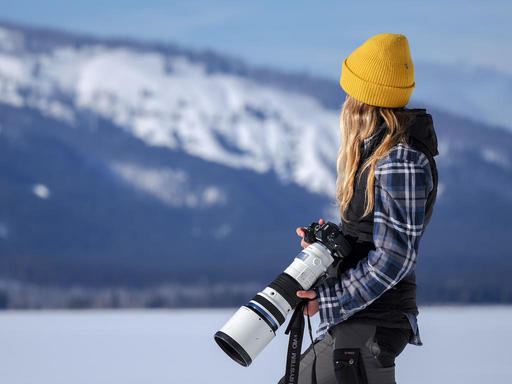Yes, it's true: I have more than one camera. And I'm guessing that you do as well.
As fun as it is having multiple bodies, I've also learned a few tricks along the way to ensure that I enjoy a seamless workflow regardless of which capture device I'm using. None of these tips are rocket science, but it's amazing how often we overlook simple things in our hectic daily lives. So in that spirit, I offer these reminders for multiple-camera photographers (which I suspect is everyone).
 Pro photographer Brooke Bartleson with the new OM System OM-1, her latest Micro Four Thirds body that she is integrating into her workflow. Photo complements of OM System.
Pro photographer Brooke Bartleson with the new OM System OM-1, her latest Micro Four Thirds body that she is integrating into her workflow. Photo complements of OM System.
All in the Family
It's so tempting to add a new brand to your kit. I go through this all of the time, with my latest temptation being the new Nikons. But the reality is that if I stick with Micro Four Thirds for my interchangeable lens bodies, I have great economy regarding my lenses. That's why I waited for the new OM-1 instead of jumping to a different brand.
Being able to tap any optic in my existing library with a new camera body gets me up and running quickly and saves me from making redundant lens purchases (which really add up).
An exception to this approach was the the Fujifilm X100V. But it wasn't really since it's not an interchangeable lens camera, so it was a one-off purchase. And it helped my remain patient while the OM-1 was being developed.
Keep in mind that compatibility isn't limited to lenses. Batteries and accessories that work in multiple bodies are a dream!
Get Those Bodies In-Sync
When my pictures move from camera to computer, I want them to display in chronological order in my library. On any given shoot, I might have an OM-1 with a long lens and the E-M10 or PEN-F capturing the wider stuff.
By taking a few minutes to check each camera's internal clock before heading out the door, I can ensure that the timestamps match, and that the files land correctly in my photo management app.
One last thought on this: If a smartphone is part of your camera arsenal, then use it as your timestamp starting point.
Latest Firmware Please
Firmware updates handle a variety of tasks ranging from bug fixes to lens compatibility to adding new features. Keeping your camera and lens firmware current ensures that everything will work with everything, and that you'll have consistent features from each camera body within a brand.
Default Camera Settings
I recommend configuring a set of default settings for your camera, and having them as a starting point for each body.
In my case, it's Program Mode, Auto ISO, Auto White Balance, RAW+Jpeg, Standard Color Profile, and Single Shot drive. I chose these settings because if something happens quickly that I want to capture, I can grab the camera and fire knowing that I will get a shot. Having to fool around with adjustments often leads to missed opportunities. And if I have to switch cameras quickly, I want those same default settings for that body as well.
Once you get the first capture, then you can then adjust settings to fine tune the image. Just remember, once you're done with the shoot, return the camera to your default settings. Make that a habit.
Final Thoughts
I find it amazing how a little pre-planning leads to a wonderfully smooth workflow, even when multiple cameras are involved. I hope you found these reminders helpful.
You can share your thoughts at the TDS Facebook page, where I'll post this story for discussion.











